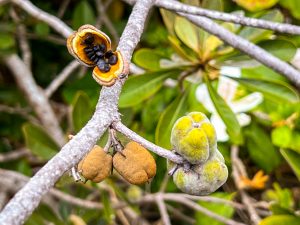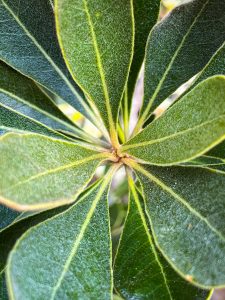Flora of Hawaii: Hoawa
Hōʻawa is an endemic plant: It is found on all of the Hawaiian Islands. There are ten species and two introduced ones, which are difficult to positively identify without flowers & fruit.
Botanical name: Pittosporum
Common Names: Kona cheesewood, Kona hoawa, Hawaiian magnolia. Lesser known names include hōʻawa, papahekii, hōʻawa lau nui, ʻaʻawa, ʻaʻawa hua kukui, aʻawahua.
Range: This plant is found in the mesic to wet forests and rarely in very dry areas. Growing from approximately 500′ to nearly 7500′ elevation, and containing a dozen species of this genera native to Hawaiʻi, Hōʻawa is well suited for nearly any environment in the islands. The plants grow as shrubs or small trees.
Flowers: The clusters of flowers are are typically a cream to white color and showy but often hidden by the large leaves. Female and male flowers are formed on separate plants and are borne in clusters. Most of the clusters form directly on the branches of the tree. The flowers are fragrant at night, suggesting the purpose of the fragrance may be to attract pollinators active at night. Hōʻawa may bloom throughout the year and both flowers and maturing capsules may be present on the tree at the same time. The flowers are unisexual and occur in groups of 8 to 20 in axillary or terminal inflorescences. Capsules are oblong-ovoid, 17 to 19 mm (0.7 in) long, and glabrous at maturity.
Fruit & Seeds: Perhaps the most notable feature of the Hōʻawa is the large, walnut-shaped, (5 to 7 mm long) fruits that open up to reveal a bright orange interior with small glossy black seeds inside. Unripe pods are dark green. As they ripen they turn yellow-orange and then to brown, and open. Each capsule contains 40 to 45 seeds arranged in two rows within the capsule. The kidney-shaped seeds are range in color from black to reddish black. Each seed is 1/4 to 3/8 inch long. Fruits are generally ripe in the winter. Observers have noted the ʻAlala (Hawaiian Crow), feeding on the fruits of Hōʻawa and are one of the few native birds that were capable of dispersing such a large fruit and are now extinct in the wild.
Leaves: Lush dark green in color, somewhat leathery. The underside of the leaves range from smooth to a tan or reddish fuzz.The edges of the leaves are smooth and slightly rolled under. The tip of the leaf gradually and concavely tapering to a narrow, sharp point.
Traditional Uses: Historically, the wood of the Hōʻawa was used by Hawaiians to make the gunwales (the upper railing/ edge) of their canoes, as firewood and for other practices by the kahuna. The outer layer of the capsules was pounded and used externally on sores. In mixtures with other botanicals it was used as a liquid massage for swollen necks and similar ailments
Landscaping: They can be used as an accent or focal shrub or small tree. The Hōʻawa makes for the perfect specimen plant, hedge, or screening plant. They are lush and green throughout the year and depending on the species, have aromatic flowers that will delight the senses night or day. Hōʻawa is a drought tolerant plant that prefers cinder or organic soils, and does well in full or partial sunlight. Once planted, the roots are known to be quite sensitive, so try and disturb them as little as possible.
Hōʻawa is the featured image on the banner of the November 1, 2022 HTMC newsletter.
Information gathered with assistance from John B. Hall.
Sources:
A Hiker’s Guide to Trailside Plants in Hawaii by John B. Hall, pg. 90
http://nativeplants.hawaii.edu/plant/view/Pittosporum_confertiflorum/
https://www.ctahr.hawaii.edu/hawnprop/plants/pit-hosm.htm


